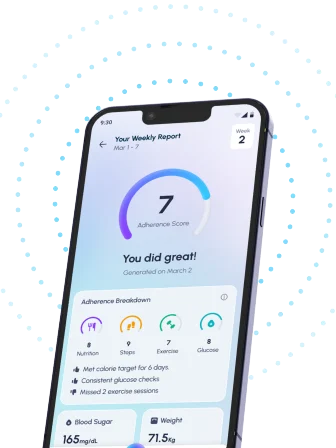Table of Contents
- Understanding Thrombophlebitis: A Comprehensive Guide
- Thrombophlebitis and Diabetes: Unveiling the Risks
- Recognizing Thrombophlebitis Symptoms: Early Detection Matters
- Thrombophlebitis Causes: How Diabetes Increases Your Risk
- Preventing Thrombophlebitis: Diabetes Management Strategies
- Frequently Asked Questions
- References
Have you ever experienced unexplained leg pain, swelling, or redness? If you have diabetes, these symptoms could be signs of a serious condition called thrombophlebitis. Understanding thrombophlebitis, specifically the increased risks, symptoms, and causes associated with diabetes, is crucial for early detection and effective management. This blog post will delve into the critical connection between diabetes and thrombophlebitis, helping you understand this condition better and take proactive steps to protect your health. We’ll explore the underlying causes, identify key warning signs, and discuss preventative measures you can take. Let’s unravel the complexities of Understanding Thrombophlebitis: Diabetes-Related Risks, Symptoms, and Causes together.
Understanding Thrombophlebitis: A Comprehensive Guide
Thrombophlebitis, the inflammation of a vein due to a blood clot, poses a significant threat, particularly for individuals with diabetes, especially prevalent in Indian and tropical countries. The high incidence of diabetes in these regions underscores the importance of understanding this condition. Nearly 15% of diabetics experience foot ulcers in their lifetime, significantly increasing the risk of amputation. This alarming statistic highlights the crucial link between diabetes and complications like thrombophlebitis.
Symptoms and Causes
Symptoms of thrombophlebitis can include pain, swelling, redness, and tenderness along the affected vein. These symptoms are often localized, but in severe cases, they can spread. In diabetics, poor blood circulation, often exacerbated by nerve damage (diabetic neuropathy), contributes to a higher risk of developing thrombophlebitis. High blood sugar levels also impair the body’s ability to heal, increasing the likelihood of infection and clot formation. Further complicating matters in tropical climates is the increased risk of insect bites and infections that can trigger thrombophlebitis.
Diabetes-Related Risks
Diabetes significantly increases the risk of thrombophlebitis for several reasons. High blood sugar levels damage blood vessels, making them more prone to clot formation. The increased risk of infections, particularly foot infections, in individuals with diabetes is a major concern. These infections can trigger thrombophlebitis, leading to serious complications. Therefore, meticulous foot care is crucial for preventing foot ulcers and subsequent thrombophlebitis.
Prevention and Management in Indian and Tropical Countries
In India and other tropical countries, effective management of diabetes and proactive foot care are essential to minimize thrombophlebitis risk. Regular blood sugar monitoring, along with maintaining healthy blood pressure and cholesterol levels, are crucial. Practicing good foot hygiene and promptly addressing any cuts, blisters, or infections are equally vital. Consult a healthcare professional immediately if you experience any symptoms suggestive of thrombophlebitis. Prompt diagnosis and treatment are key to preventing serious complications, particularly in high-risk populations. Early intervention can significantly reduce the risk of limb amputation, a devastating consequence of untreated thrombophlebitis in diabetics. Managing underlying conditions, such as diabetes, is crucial; for more information on other serious conditions, you may find our article on Paraneoplastic Pemphigus: Symptoms, Causes and Treatment helpful in understanding the importance of early diagnosis and treatment. While this article focuses on a different condition, the underlying principles of proactive healthcare and early intervention are equally applicable. It’s also important to be mindful of other health concerns and to practice good hygiene to prevent infections, as discussed in our article on Hepatitis.
Thrombophlebitis and Diabetes: Unveiling the Risks
The Concerning Link Between Diabetes and Thrombophlebitis
Diabetes significantly increases the risk of developing thrombophlebitis, a condition involving blood clot formation in the veins. This heightened vulnerability is linked to several factors. Individuals with diabetes often experience impaired blood flow and increased blood viscosity, creating an environment conducive to clot formation. Furthermore, hypertension, a condition affecting over 60% of people with diabetes in India, as reported by the IDF, further exacerbates this risk. The chronic inflammation associated with poorly managed diabetes also plays a crucial role. To understand this better, read more about How Does Diabetes Affect Blood Flow?
Recognizing the Symptoms in Tropical Climates
Symptoms of thrombophlebitis can manifest differently depending on location and climate. In hot and humid tropical countries like those prevalent in India, swelling might be less pronounced, potentially delaying diagnosis. However, pain, redness, and tenderness along the affected vein remain consistent indicators. Look out for warmth in the area, a key symptom often overlooked. Early detection is crucial, as untreated thrombophlebitis can lead to serious complications, including pulmonary embolism.
Preventive Measures and Seeking Medical Attention
Maintaining optimal blood glucose levels is paramount in mitigating the risk of thrombophlebitis for individuals with diabetes. Regular exercise, a balanced diet, and strict adherence to prescribed medications are essential. In India and similar tropical regions, prioritize hydration to improve blood flow. If you’re planning travel, check out these Essential Tips for a Safe & Healthy Journey if you have diabetes. If you experience any symptoms suggestive of thrombophlebitis, seek immediate medical attention. Prompt diagnosis and treatment are vital to prevent severe complications and ensure a positive health outcome.
Recognizing Thrombophlebitis Symptoms: Early Detection Matters
Thrombophlebitis, the inflammation of a vein due to a blood clot, poses a significant risk for individuals with diabetes, especially in warmer climates prevalent across many Indian and tropical countries. The alarming statistic that 50% of diabetes cases worldwide remain undiagnosed (diabetesatlas.org) highlights the critical need for increased awareness and proactive health management. Early detection of thrombophlebitis is crucial to prevent serious complications.
Common Symptoms to Watch For
Recognizing the symptoms is your first line of defense. Look out for pain, swelling, and redness along a vein, often in the leg. The affected area may feel warm to the touch. You might also experience tenderness when pressure is applied. In some cases, thrombophlebitis can be accompanied by fever. These symptoms can be subtle initially, making regular self-examination essential, particularly for those with diabetes who are at heightened risk due to impaired blood circulation and increased blood clotting tendency. Understanding other potential health issues, like those detailed in 10 Pancreatitis Symptoms: What You Need to Know, can also help you better understand your overall health.
Seeking Prompt Medical Attention
Don’t ignore these warning signs. If you experience any of the symptoms mentioned above, especially if you have diabetes, seek immediate medical attention. Prompt diagnosis and treatment are vital to prevent the clot from traveling to the lungs (pulmonary embolism), a life-threatening condition. Early intervention can significantly improve your prognosis and quality of life. In India and other tropical regions, access to healthcare can vary, so proactive health management and early consultation with a healthcare professional are even more critical. Conditions like Dengue fever with thrombocytopenia can sometimes present similar symptoms, highlighting the importance of accurate diagnosis.
Thrombophlebitis Causes: How Diabetes Increases Your Risk
Diabetes significantly elevates the risk of developing thrombophlebitis, a condition characterized by inflammation of a vein typically caused by a blood clot. This increased susceptibility stems from several interconnected factors. One key factor is the higher prevalence of vascular complications in individuals with diabetes. High blood sugar levels damage blood vessels, making them more prone to inflammation and clot formation. This damage is particularly prevalent in the legs and feet, common sites for thrombophlebitis.
Understanding the Connection: Diabetes and Blood Vessel Damage
The chronic hyperglycemia associated with diabetes leads to thickening and stiffening of blood vessel walls, a process known as atherosclerosis. This process, coupled with impaired blood flow, creates an environment ripe for clot formation. Further compounding the risk, diabetics often experience impaired immune function, reducing the body’s ability to effectively combat inflammation and resolve blood clots. This means that even relatively small injuries or venous stasis (slow blood flow) can lead to a more severe thrombophlebitis episode.
The Role of Diabetic Nephropathy
The link between diabetes and kidney disease further underscores the heightened risk. Nearly 30% of individuals with diabetes develop diabetic nephropathy (kidney disease), which can indirectly contribute to thrombophlebitis. Kidney disease can disrupt the body’s fluid and electrolyte balance, potentially leading to increased blood viscosity (thickness), thereby promoting clot formation. The impaired kidney function can also impact the body’s natural clot-dissolving mechanisms, increasing the likelihood of thrombophlebitis and its complications. Understanding the complications of diabetes is crucial; for example, it’s important to know that diabetes can also lead to tachycardia.
Seeking Help in India and Tropical Countries
Recognizing the symptoms of thrombophlebitis, such as pain, swelling, redness, and warmth along a vein, is crucial for timely intervention. In India and tropical countries, where diabetes prevalence is high, prompt medical attention is vital to prevent serious consequences. Consult a healthcare professional immediately if you experience any of these symptoms, especially if you have diabetes. Early diagnosis and treatment can significantly improve outcomes and reduce the risk of long-term complications. It’s also important to be aware of other conditions that might contribute to diabetes, such as Hepatitis C.
Preventing Thrombophlebitis: Diabetes Management Strategies
Managing diabetes effectively is crucial in preventing thrombophlebitis, a serious condition involving blood clot formation in veins. Given that up to 80% of Type 2 diabetes cases can be delayed or prevented through lifestyle changes as highlighted by research, proactive management is key. This is especially important in hot and humid climates prevalent in many Indian and tropical countries, where dehydration can exacerbate clotting risks.
Lifestyle Modifications for Thrombophlebitis Prevention
Maintaining a healthy weight is paramount. Obesity significantly increases the risk of both diabetes and thrombophlebitis. Regular physical activity, even moderate exercise like brisk walking for 30 minutes most days of the week, improves blood circulation and helps manage blood sugar levels. Incorporating regular exercise into your daily routine is especially important in warmer climates where prolonged inactivity can increase the risk of complications.
Dietary Changes for Blood Sugar Control
A balanced diet low in saturated fats, refined carbohydrates, and processed foods is essential. Focus on consuming plenty of fruits, vegetables, and whole grains. Regular blood sugar monitoring is crucial for early detection of fluctuations that can contribute to the development of thrombophlebitis. Consult with your doctor or a registered dietitian to develop a personalized meal plan tailored to your specific needs and the climate you live in. For more tips on effective diabetes management, see our article on 10 Proven Tips for Effective Diabetes Management.
Hydration and Medication Adherence
Staying well-hydrated is particularly important in tropical climates, as dehydration can thicken your blood, increasing the risk of clotting. Always ensure you’re drinking sufficient amounts of water throughout the day. Furthermore, strict adherence to prescribed diabetes medications is vital in maintaining stable blood sugar levels and reducing the overall risk of complications like thrombophlebitis. Regular check-ups with your healthcare provider are crucial for monitoring your condition and making necessary adjustments to your treatment plan. Learning how to prevent long-term complications is also key; check out our guide on How to Prevent Long-Term Complications of Diabetes: Easy Tips.
Remember, proactive management of diabetes is your best defense against thrombophlebitis. Consult your doctor to create a personalized prevention plan suited to your individual needs and the climate in your region.
Frequently Asked Questions on Understanding Thrombophlebitis
Q1. What is thrombophlebitis and who is most at risk?
Thrombophlebitis is vein inflammation caused by blood clots. People with diabetes, especially those in tropical regions like India, are at significantly higher risk due to poor circulation and higher infection rates.
Q2. What are the symptoms of thrombophlebitis?
Symptoms include pain, swelling, redness, and tenderness along the affected vein. If you experience these, seek immediate medical attention.
Q3. Why does diabetes increase the risk of thrombophlebitis?
High blood sugar damages blood vessels, making clot formation more likely. Diabetes also impairs circulation, nerve function, and healing, increasing susceptibility to infections that worsen thrombophlebitis.
Q4. How can I prevent thrombophlebitis, particularly if I have diabetes?
Prevention involves meticulous foot care, regular blood sugar monitoring, maintaining healthy blood pressure and cholesterol, and promptly treating any infections. Proactive health management is key.
Q5. What are the potential complications of thrombophlebitis, and what should I do if I suspect I have it?
Serious complications include pulmonary embolism (blood clot in the lungs) and limb amputation. Early diagnosis and treatment are crucial. If you suspect thrombophlebitis, seek immediate medical attention.
References
- A Practical Guide to Integrated Type 2 Diabetes Care: https://www.hse.ie/eng/services/list/2/primarycare/east-coast-diabetes-service/management-of-type-2-diabetes/diabetes-and-pregnancy/icgp-guide-to-integrated-type-2.pdf
- Diabetes Mellitus: Understanding the Disease, Its Diagnosis, and Management Strategies in Present Scenario: https://www.ajol.info/index.php/ajbr/article/view/283152/266731




